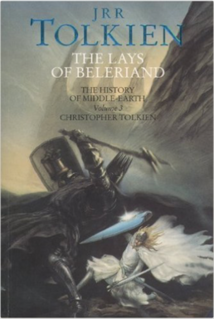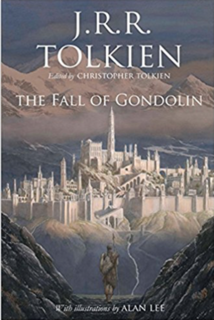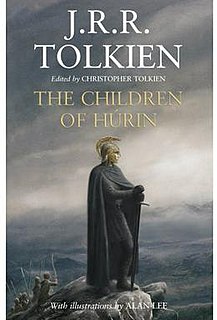Christopher John Reuel Tolkien is the third son of the author J. R. R. Tolkien (1892–1973), and the editor of much of his father's posthumously published work. He drew the original maps for his father's The Lord of the Rings, which he signed C. J. R. T.

Unfinished Tales of Númenor and Middle-earth is a collection of stories and essays by J. R. R. Tolkien that were never completed during his lifetime, but were edited by his son Christopher Tolkien and published in 1980. Many of the tales within are retold in The Silmarillion, albeit in modified forms; the work also contains a summary of the events of The Lord of the Rings told from a less personal perspective.
Túrin Turambar is a fictional character in J. R. R. Tolkien's legendarium. "Turambar and the Foalókë", begun in 1917, is the first appearance of Túrin in the legendarium. J.R.R. Tolkien consciously based the story on the medieval tale of Kullervo in the Finnish mythological poem Kalevala, saying that it was "an attempt to reorganize...the tale of Kullervo the hapless, into a form of my own". Also called "The Tale of Grief", "Narn i Chîn Húrin", commonly called "The Narn", it tells of the tragic fates of the children of Húrin, namely his son Túrin (Turambar) and his daughter Nienor. Excerpts of the story were published before, in The Silmarillion (prose), Unfinished Tales (prose), The Book of Lost Tales Part II (prose), The Lays of Beleriand and most recently in 1994 in The War of the Jewels (prose), the latter three part of The History of Middle-earth series.

The War of the Jewels (1994) is the 11th volume of Christopher Tolkien's series The History of Middle-earth, analysing the unpublished manuscripts of his father J. R. R. Tolkien.

Alan Lee is an English book illustrator and movie conceptual designer. He was born in Middlesex, England, and studied at the Ealing School of Art.
A portion of the Narn i Chîn Húrin or The Tale of the Children of Húrin is a part of the book Unfinished Tales by the English author J. R. R. Tolkien. It is a prose version of an earlier narrative poem called The Lay of the Children of Húrin. A complete version of the Narn called The Children of Húrin, edited by Christopher Tolkien, was released as a new book in 2007.
Húrin is a fictional character in the Middle-earth legendarium of J. R. R. Tolkien. He is introduced in The Silmarillion as a hero of Men during the First Age, said to be the greatest warrior of both the Edain and all the other Men in Middle-earth. Húrin Thalion was the elder son of Galdor the Tall of the House of Hador and Hareth of the Haladin, and he had a younger brother named Huor.

The Lays of Beleriand, published in 1985, is the third volume of Christopher Tolkien's 12-volume book series, The History of Middle-earth, in which he analyzes the unpublished manuscripts of his father J. R. R. Tolkien.
Niënor, also known as Níniel, is a fictional character from J. R. R. Tolkien's Middle-earth legendarium, appearing in the Narn i Chîn Húrin told in full in The Children of Húrin and briefly in The Silmarillion. Early versions of the story are Turambar and the Foalókë and The Lay of the Children of Húrin.

The Fall of Gondolin is, in the writings of J. R. R. Tolkien, one of the original Lost Tales which formed the basis for a section in his later work, The Silmarillion. A stand-alone, book-length version of the story was published on 30 August 2018. The Fall of Gondolin is one of three stories from the First Age of Middle-earth to be published as a stand-alone book: the other two are Beren and Lúthien and The Children of Húrin.
In J. R. R. Tolkien's Middle-earth legendarium, Urwen, better known by her nickname Lalaith ("Laughter"), was the second child of Húrin Thalion and Morwen Edhelwen and the sister of Túrin Turambar. She was born in spring of the Year of the Sun 466 of the First Age.
Morwen is a fictional character from J. R. R. Tolkien's Middle-earth legendarium. She is featured in The Silmarillion, The Children of Húrin and The Wanderings of Húrin.
The following outline is provided as an overview of and topical guide to the real-world history and notable fictional elements of J. R. R. Tolkien's fantasy universe.
The term Middle-earth canon, also called Tolkien's canon, is used to loosely define the published writings of J. R. R. Tolkien regarding Middle-earth as a whole. The term is also used in Tolkien fandom to promote, discuss and debate the idea of a consistent fictional canon within a given subset of Tolkien's writings.
The Lay of the Children of Húrin is a long epic poem by J. R. R. Tolkien, which takes place in his fictional fantasy-world, Middle-earth. It tells of the life and the ill fate of Túrin Turambar, the son of Húrin. It is written in alliterative verse and exists in several versions, but was never finished. The poem was published after the author's death by his son Christopher in The Lays of Beleriand, the third volume of The History of Middle-earth.

The Children of Húrin is an epic fantasy novel which forms the completion of a tale by J. R. R. Tolkien. He wrote the original version of the story in the late 1910s, revised it several times later, but did not complete it before his death in 1973. His son, Christopher Tolkien, edited the manuscripts to form a consistent narrative, and published it in 2007 as an independent work. The book contains 33 illustrations by Alan Lee, eight of which are full-page and in colour. The story is one of three "great tales" set in the First Age of Tolkien's Middle-earth, the other two being Beren and Lúthien and The Fall of Gondolin.
Tolkien's legendarium is the body of J. R. R. Tolkien's mythopoeic writing that forms the background to his The Lord of the Rings, a high fantasy novel which is widely considered to be his magnum opus.

The Silmarillion is a collection of mythopoeic works by English writer J. R. R. Tolkien, edited and published posthumously by his son, Christopher Tolkien, in 1977, with assistance from Guy Gavriel Kay. The Silmarillion, along with J. R. R. Tolkien's other works, forms an extensive, though incomplete, narrative that describes the universe of Eä in which are found the lands of Valinor, Beleriand, Númenor, and Middle-earth, within which The Hobbit and The Lord of the Rings take place.






